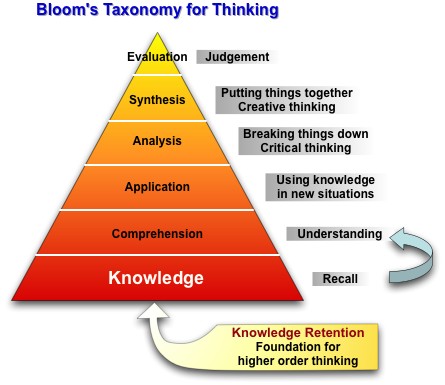Related Flashcards
Cards In This Set
| Front | Back |
 Bloom's Taxonomy - First Level KNOWLEDGE - remembering of previously learned material |
Trigger Verbs:
count, define, outline, draw, identify, label, list, match, name, recall, select, write
|
|
Bloom's Taxonomy - Second Level
COMPREHENSION - ability to understand the meaning of material
|
Trigger Verbs:
compare, compute, contrast, distinguish, estimate, explain, predict, rewrite
|
|
Bloom's Taxonomy - Third Level
APPLICATION - using learned material in a new situation
|
Trigger Verbs:
calculate, classify, complete, examine, generalize, modify, solve, utilize
|
|
Bloom's Taxonomy - Fourth Level
ANALYSIS - separation a complex whole into its parts
|
Trigger Verbs:
analyze, arrange, break down, diagram, relate, select, subdivide
|
|
Bloom's Taxonomy - Fifth Level
SYNTHESIS - putting parts together to form a new whole
|
Trigger Verbs:
combine, construct, create, design, formulate, organize, plan, propose rearrange
|
|
Bloom's Taxonomy - Sixth Level
EVALUATION - ability to judge the value of specific items
|
Trigger Verbs:
assess, conclude, critique, justify, support, determine, evaluate
|
|
Bloom's Taxonomy refers to a classification of the different objectives that educators set for students (learning objectives). Skills in the cognitive domain revolve around knowledge, comprehension, and critical thinking of a particular topic. Traditional education tends to emphasize the skills in this domain, particularly the lower-order objectives.
|
Bloom's Taxonomy Verbs
Use verbs aligned to Bloom's Taxonomy to create discussion questions and lesson plans that ensure your students' thinking progresses to higher levels.
|





